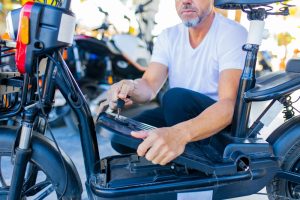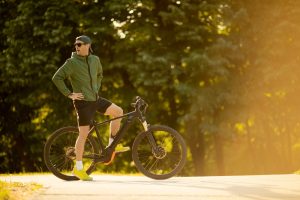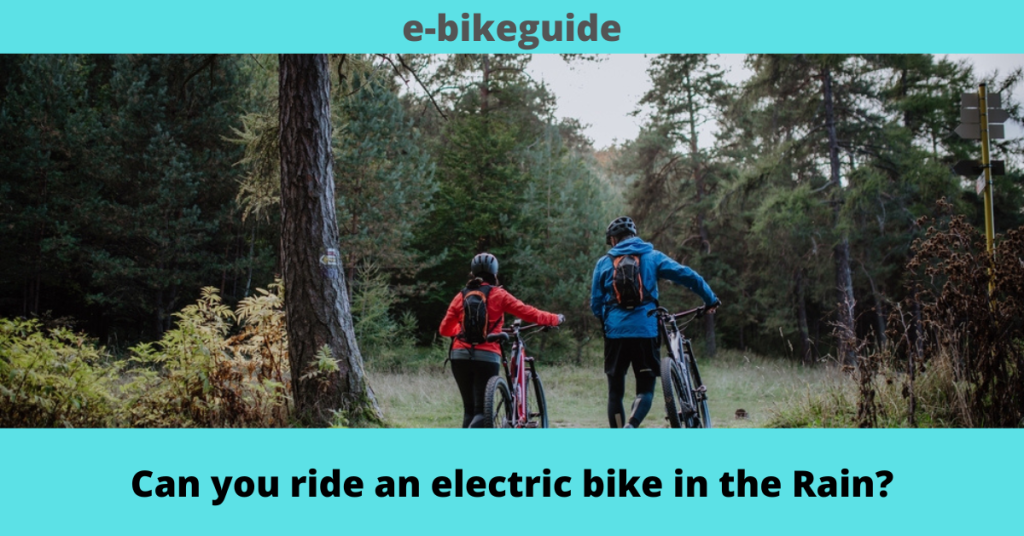
Consider your intended riding time before making a final decision on an electric bike. Do you often enjoy long rides on trail systems, or can you ride an electric bike in the Rain? Whether you’re commuting or just out for a ride in the Rain, an e-bike is an ideal choice. Understanding your battery’s required operating time can help you choose the best model. Can you ride an electric bike in the Rain? Here’s how to make the most of your bike in rainy weather. You can also prepare for your bike trips by knowing what to anticipate. Learn everything you need to know about e-bike batteries in this chapter so you can hit the road confident and ready for the ride of a lifetime. A lithium-ion battery, or some other variant of it, is the greatest type of battery currently available. When compared to traditional lead-acid batteries, these ones are more compact and reliable. It is important to think about the watt-hours (Wh) rating of the battery when looking for an electric bike.
This rating is a measure of the battery’s power and lifespan. More watt-hours mean more distance. Choose a bike with a range and power level appropriate for your intended riding length. Finally, think about how the time it takes to recharge the battery affects your e-bike plans. A battery’s lifespan is affected by a number of variables, such as its capacity and the amount of help turned on. Just a little bit of pedaling can save power and go you further. On average, a single charge will take you between 25 and 70 miles. Based on our testing, we know that the normal 52V battery can power us for 50 miles at a pace of 10 mph when we pedal very lightly. On the other hand, the range increased to 77 miles at ten mph when using level 3 pedal assist. Overall battery life expectancy varies widely between battery types.
The average lifespan of a lead-acid battery is between 200 and 300 charging cycles, whereas a lithium battery can handle 500 to 1,000. We’re an e-bike startup out of San Diego with a commitment to developing industry-changing products without sacrificing quality or price. Our bikes are built to be the gold standard in terms of speed, durability, range, and price. We’re confident that you’ll agree that our direct sales model results in the best value for your money and the highest quality of service. You get an exceptional bike at a ridiculously low price. First, we did all of our tests while riding at full power. The identical experiment was then performed with pedal assistance. The rest of the testing criteria: Controls: The rider’s payload, including clothing and equipment, is roughly 190 pounds. To maintain traction, we keep the factory tires inflated to 60 psi.
Increasing the tire pressure will increase the vehicle’s range, but the ride quality will suffer. The road surface has a few irregularities but otherwise is in good condition. Small walls called “bumps” slow bikes down by colliding with their wheels. Decline on a Hillside The ground is rather flat, but the test circuit has several inclines and declines. Wind Totally windless locations are unusual. The test circuit does see some wind, but it often only blows in one direction. Temperatures of 80 degrees or higher are typical. The range will be less in cold conditions. Range-Affecting Factors Different aspects of electric bicycles determine the range you can travel between charges. There is no set number of miles or hours you may ride each charge; the range is there for guidance, much like a car’s mpg rating.
10 Tips for Riding an Electric Bike in the Rain

It’s no secret that riding an electric bike is fun, but any rider should take extra precautions when doing so in the Rain. Whether it’s the gear you wear or the way your electric bike is set up, your top priority should be riding safely in the Rain. This post will discuss some safety measures to take into account before heading out on your electric bike while it’s raining. For the most part, you can ride an electric bike in the Rain. Since not all brands or models are created equal, you should check with your electric bike’s maker to make sure it can be ridden in the Rain. Electric bicycles are efficient in any climate. In addition to their many watertight features, they should make your trip seem safe and comfortable. To be more specific, Hotebike electric bicycles are watertight, making them ideal for use in wet climates such as rainy cities or for storing in damp garages. Before you head out on your electric bike for a ride in the Rain, though, consider these safety measures.
1. Find the right bike light

The acquisition of superior lighting equipment is a prerequisite to nighttime travel. They serve two purposes: they alert drivers and riders to your presence, and they illuminate the road ahead. Before setting out on your ride, double-check that all of your lights are on and will stay on. It’s also a good idea to bring along a backup set of lights in case any of yours go out early. Nowadays, it’s not hard to get a powerful, long-lasting bicycle light that won’t break the bank, thanks to LED technology. There are lights that can produce as much as 4200 lumens. The intensity of these bulbs is six times that of standard automobile lights. No matter if you’re riding your electric bike at night, in the morning, or in the fog, you’ll need bright lights to see where you’re going and to signal turns.
2. Utilize objects with reflecting surfaces

In addition to lighting, luminous gear and clothes are crucial for safety when riding electric bicycles at night. Having reflective gear on you will make you stand out from other vehicles on the road and draw the attention of drivers around you. There has been a dramatic rise in the variety of bicycle reflective equipment in recent years, and consumers now have their pick of several different reliable manufacturers. Also, reflective tapes applied to your electric bike could help you stand out more.
3. Wear proper attire.

In certain places, the weather during the day on an electric bike is vastly different from the weather at night, so you may want to think about what you want to wear. Think about what will keep you warm as well as what will make you visible in the dark when deciding what to wear. As was already indicated, one of the first steps is to dress reflectively so as to draw the attention of passing motorists. A fluorescent jacket or helmet lights are two examples, but reflective pants or leggings also help a lot. Wearing reflective clothes increases your visibility and helps you avoid any danger.
4. Organize your travels

Not ideal for a three-hour long ride, but we understand that not everyone can organize their lives around daylight hours. Planning and organizing a safe cycling route in advance can also help while riding an electric bike at night, whether for a scheduled training session or simply to run a few more kilometers in a week. If you want to have a more organized and secure ride, plan out the route you will take beforehand. In order to avoid dangerous situations, you should ride your bike only on well-known paths that are well-lit, well-paved, and not too popular. It’s also important to plan which routes you’ll take, as riding on uneven bike lanes at night might be dangerous due to the lack of visibility caused by the sun setting. It’s best to save long rides for the weekend or other times when you’ll have plenty of time to get there and back.
5. Take the bike out with some pals!

Riding in the evening with a friend or a group of friends not only makes exercising more fun and inspiring but also keeps everyone on the team safe. I encourage you to consider inviting any of your fellow cyclist pals to join you. On top of that, it’s smart to travel in a group or with a friend in case of an unexpected incident. There is enough room for everyone. There will always be someone on the team who can lend a hand if something goes wrong or if you run into mechanical difficulties. You should check that everyone has what they need to fix any mechanical issues before setting out on the ride. For the sake of everyone’s safety, it may be wise to designate certain responsibilities before setting out. Lastly, make sure that someone in your party has a mobile phone in case of an unexpected situation.
6. driving an electric bike Defense when biking

Nighttime riding makes this rule all the more crucial, but it is still necessary during the day. Protect yourself and others on the road by practicing defensive cycling techniques. At night, it might be more difficult to see cars and for other drivers to see you. Please pause at the intersection and check for approaching cars. If you’re driving on a small road and you see a car approaching from behind, pull over as far as possible so it can pass safely. Though listening to music while riding is a lot of fun, it’s not a good idea to do so at night unless you’re using Bluetooth speakers or some other method to ensure that you remain fully attentive at all times.
7. Search for rounded areas

If it rains for the first time before the oil and dirt are wiped away, the ground will be smooth afterward. It’s because of this that your trip could become a roller coaster with numerous smooth points you can’t see coming. If you must ride in the Rain, try to avoid puddles or pools of water, and pay special attention to puddles of unusual colors, as they may hide gas or lubricating chemicals that will make your ride more comfortable. When it rains, lines drawn on the road (such as lane markings) can become very dangerous. Similarly, when the tracks are wet, trains might be difficult to control. Get as far away from the rail as possible while still maintaining a 90-degree angle.
8. Install fenders on your bike.

When riding a bike in the Rain, fenders can protect your clothing from getting soaked. Although electric bikes are generally waterproof (the gearbox or engine can tolerate heavy splashes, and the battery won’t fail due to being wet), mudguards are still a good idea. This shields not only you and your bike but also your battery and other expensive parts from flying road debris.
9. Get dressed for the weather.

Can you ride an electric bike in the rain? You can, but it’s not all that easy. Here’s the lowdown on how to keep your bike running smoothly when the weather takes a turn for the worse. Riding while wet is a challenge because of how quickly you become soaked. You should dress in layers to keep you warm and dry. Riding in the Rain requires a pair of glasses and a lightweight waterproof raincoat or jacket. When it’s wet out, cotton clothing is a bad idea. When venturing into wetlands, it’s best to wear clothes made of synthetic fibers or wool. You should also think about donning some gloves to keep your hands toasty and dry.
10. Safeguard your equipment from the elements.

You can store your belongings dry and secure in hanging baskets and bags. Riding through the Rain will wet everything in the end, as was mentioned before. Make sure that your gear is similarly protected from the elements as you are. Take precautions to prevent water damage to your electronic devices, whether you’re traveling with a laptop, MP3 player, or GPS. Most people who ride electric bikes find that a dry bag, which is both watertight and airtight, is the most convenient and reliable method to carry their gear.
conclusion

Can you ride an electric bike in the Rain? Yep, but here’s how to ride safely in the Rain. Can you ride an electric bike in the Rain? The quick response is “yes.” Although, like with anything else, there are basic rules of thumb that, if followed, will keep you safe and out of danger. A rainstorm won’t damage an e-electric bike’s system. It rains much more frequently in Europe than it does here, and the three million+ e-bike riders there can attest to that. To what extent, though, are electric bikes safe to ride in the big, sudden downpours and “rain events” that we see in Australia? Don’t worry. If your ebike is well-made, riding through a storm or returning home from work during one of our rain events won’t be a problem.



